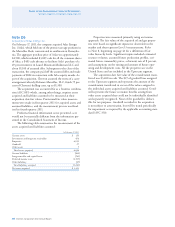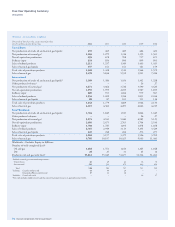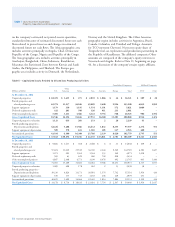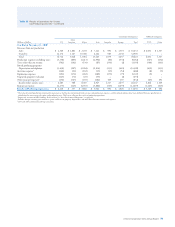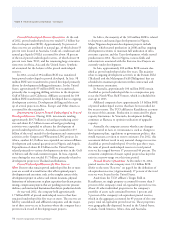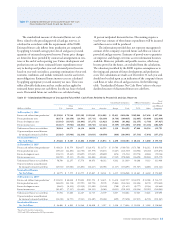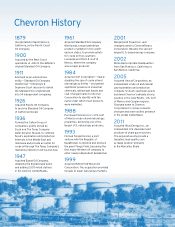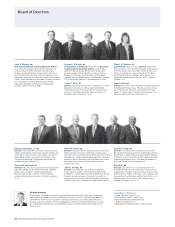Chevron 2012 Annual Report Download - page 78
Download and view the complete annual report
Please find page 78 of the 2012 Chevron annual report below. You can navigate through the pages in the report by either clicking on the pages listed below, or by using the keyword search tool below to find specific information within the annual report.
Table V Reserve Quantity Information
Reserves Governance e company has adopted a compre-
hensive reserves and resource classication system modeled
after a system developed and approved by the Society of
Petroleum Engineers, the World Petroleum Congress and
the American Association of Petroleum Geologists. e sys-
tem classies recoverable hydrocarbons into six categories
based on their status at the time of reporting – three deemed
commercial and three potentially recoverable. Within the
commercial classication are proved reserves and two cat-
egories of unproved: probable and possible. e potentially
recoverable categories are also referred to as contingent
resources. For reserves estimates to be classied as proved,
they must meet all SEC and company standards.
Proved oil and gas reserves are the estimated quantities
that geoscience and engineering data demonstrate with rea-
sonable certainty to be economically producible in the future
from known reservoirs under existing economic conditions,
operating methods and government regulations. Net proved
reserves exclude royalties and interests owned by others and
reect contractual arrangements and royalty obligations in
eect at the time of the estimate.
Proved reserves are classied as either developed or unde-
veloped. Proved developed reserves are the quantities expected
to be recovered through existing wells with existing equip-
ment and operating methods.
Due to the inherent uncertainties and the limited nature
of reservoir data, estimates of reserves are subject to change as
additional information becomes available.
Proved reserves are estimated by company asset teams
composed of earth scientists and engineers. As part of the
internal control process related to reserves estimation, the
company maintains a Reserves Advisory Committee (RAC)
that is chaired by the Manager of Corporate Reserves, a cor-
porate department that reports directly to the Vice Chairman
responsible for the company’s worldwide exploration and
production activities. e Manager of Corporate Reserves has
more than 30 years’ experience working in the oil and gas
industry and a Master of Science in Petroleum Engineering
degree from Stanford University. His experience includes
more than 15 years of managing oil and gas reserves processes.
He was chairman of the Society of Petroleum Engineers Oil
and Gas Reserves Committee, served on the United Nations
Expert Group on Resources Classication, and is a past mem-
ber of the Joint Committee on Reserves Evaluator Training
and the California Conservation Committee. He is an active
member of the Society of Petroleum Evaluation Engineers
and serves on the Society of Petroleum Engineers Oil and Gas
Reserves Committee.
All RAC members are degreed professionals, each
with more than 15 years of experience in various aspects of
reserves estimation relating to reservoir engineering, petro-
leum engineering, earth science or nance. e members
are knowledgeable in SEC guidelines for proved reserves
classication and receive annual training on the preparation
of reserves estimates. e reserves activities are managed by
two operating company-level reserves managers. ese two
reserves managers are not members of the RAC so as to pre-
serve corporate-level independence.
Consolidated Companies Aliated Companies
Other
U.S. Americas Africa Asia Australia Europe Total TCO Other
Year Ended December 31, 2012
Average sales prices
Liquids, per barrel $ 95.21 $ 87.87 $ 109.64 $ 102.46 $ 103.06 $ 108.77 $ 101.61 $ 89.34 $ 83.97
Natural gas, per thousand cubic feet 2.65 3.59 1.22 6.03 10.99 10.10 5.42 1.36 5.39
Average production costs, per barrel2 16.99 18.38 12.14 16.71 4.86 15.72 15.46 4.42 18.73
Year Ended December 31, 20113
Average sales prices
Liquids, per barrel $ 97.51 $ 89.87 $ 109.45 $ 100.55 $ 103.70 $ 107.11 $ 101.63 $ 94.60 $ 90.90
Natural gas, per thousand cubic feet 4.02 2.97 0.41 5.28 9.98 9.91 5.29 1.60 6.57
Average production costs, per barrel2 15.08 14.62 9.48 17.47 3.41 11.44 13.98 4.23 10.54
Year Ended December 31, 20103
Average sales prices
Liquids, per barrel $ 71.59 $ 66.22 $ 78.00 $ 70.96 $ 76.43 $ 76.10 $ 73.24 $ 63.94 $ 64.92
Natural gas, per thousand cubic feet 4.25 2.52 0.73 4.45 6.76 7.09 4.55 1.41 4.20
Average production costs, per barrel2 13.11 11.86 8.57 11.71 2.55 9.42 10.96 3.14 7.37
1 e value of owned production consumed in operations as fuel has been eliminated from revenues and production expenses, and the related volumes have been deducted from net
production in calculating the unit average sales price and production cost. is has no eect on the results of producing operations.
2 Natural gas converted to oil-equivalent gas (OEG) barrels at a rate of 6 MCF = 1 OEG barrel.
3 2011 and 2010 conformed to 2012 presentation.
Table IV Results of Operations for Oil and
Gas Producing Activities — Unit Prices and Costs1
76 Chevron Corporation 2012 Annual Report




